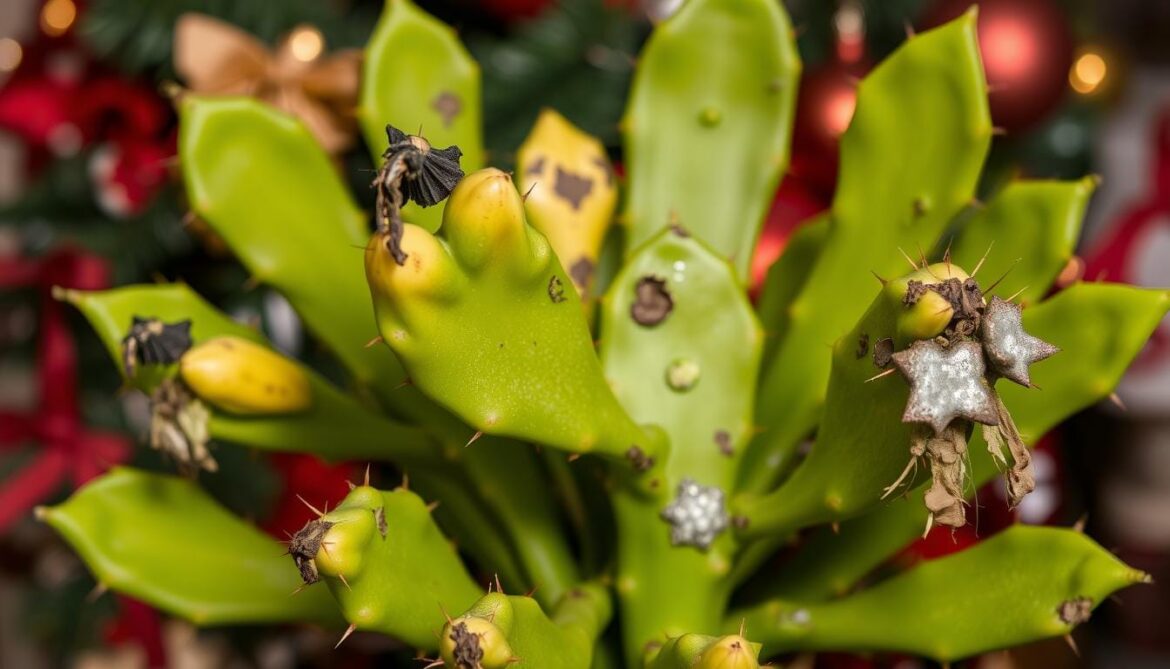As the holiday season comes, our homes are filled with the bright blooms of Christmas cacti. These plants, from Brazil’s coastal rainforests, are festive favorites. But, they can get sick from various diseases that harm their health.
In this guide, we’ll look at common Christmas cactus diseases. We’ll teach you how to stop, spot, and treat them.
Key Takeaways
- Christmas cacti are susceptible to various diseases, including stem rot, root rot, botrytis blight, and necrotic spot virus.
- These issues are often related to environmental factors such as overwatering, poor lighting, or temperature fluctuations.
- Proper care and early identification of symptoms are crucial for maintaining healthy Christmas cacti.
- Fungal diseases like powdery mildew and bacterial soft rot can also affect these plants.
- Pests such as aphids and mealybugs can contribute to the spread of diseases in Christmas cacti.
Introduction to Christmas Cactus Diseases
Christmas cacti are popular holiday plants with bright, tubular flowers in red, pink, and white. But, they can get sick from different diseases. Knowing about these diseases helps us prevent and treat them.
Cactus plant diseases are common and can be very harmful. Schlumbergera rot is a fungal infection that can rot the stems and roots. This leads to wilting and can kill the plant. Holiday cactus wilting can also be caused by bacterial soft rot, which spreads quickly through the plant.
Christmas cacti can also get viral diseases like impatiens necrotic spot virus. This virus can make the leaves discolored and deformed. Problems like bad lighting, wrong temperatures, and poor watering can make plants more likely to get sick.
Learning about the diseases that affect Christmas cacti and their causes helps us keep them healthy. In the next parts, we’ll look at symptoms, how to identify them, and how to treat them. This will help you keep your Christmas cacti happy and healthy for many years.
Common Symptoms of Christmas Cactus Diseases
Gardeners need to watch for signs of Christmas cactus diseases. These plants are loved for their bright flowers but can face health issues. Knowing the signs helps us act fast to keep our plants healthy.
Identifying Leaf Discoloration
Leaf discoloration is a common problem. Leaves might turn yellow due to nutrient lack or too much sun. They can also turn reddish-pink from too much light. Adjusting the light can prevent these color changes.
Recognizing Stunted Growth
Stunted growth can mean root rot or pests. Stem rot, including basal stem rot, often happens in cool, damp soil. Root rot causes plants to wilt and die, with soggy, black, or reddish-brown roots. Fixing these issues with better watering and soil care can help your cactus grow strong again.
Understanding Flower Drop
Flower drop is a big disappointment. It can be caused by sudden changes in environment, like temperature or too much water. Impatiens necrotic spot virus (INSV) can also cause spotted, yellow, or wilted leaves and stems, leading to flower drop. Keeping care consistent and watching for pests can stop this problem.
Knowing the symptoms of Christmas cactus diseases helps us act quickly. By watching for leaf discoloration, stunted growth, and flower drop, we can keep our plants healthy. With the right care, our Christmas cacti will bloom beautifully every season.
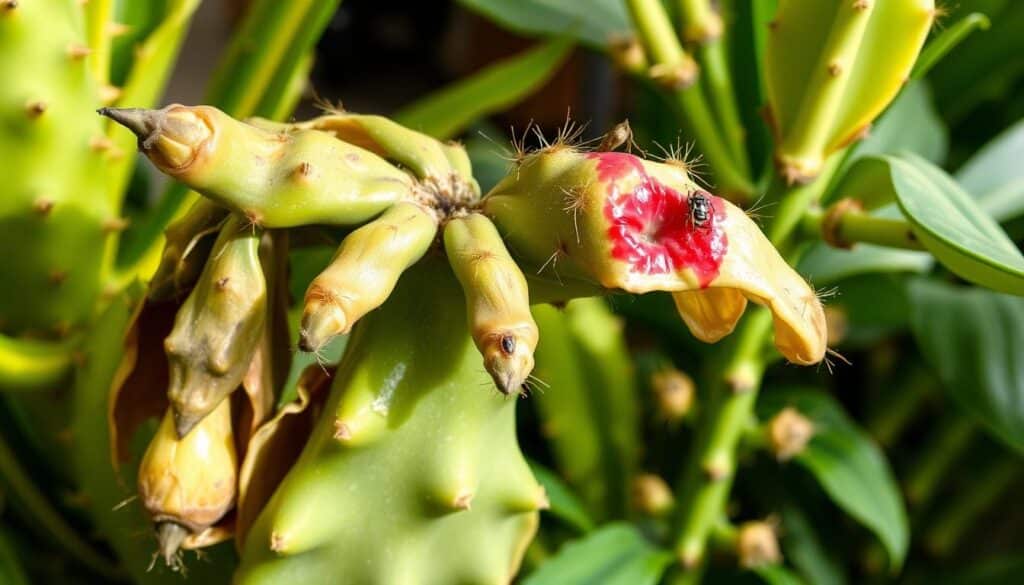
Fungal Diseases Affecting Christmas Cactus
Christmas cacti, also known as Schlumbergera or holiday cacti, face many fungal diseases. These can harm their health. It’s important to spot and treat these problems quickly to keep your plant healthy.
Root Rot: Causes and Signs
Root rot is a common issue in Christmas cacti. It’s caused by too much water, which leads to fungi like Phytophthora or Pythium. Signs include wilted leaves, yellowing, and black, rotting roots with a bad smell.
Powdery Mildew: Identification
Powdery mildew is another problem. It looks like white or gray powder on the plant. It loves warm, humid places and spreads fast if not treated. Spotting it early is key to stopping it.
Treatment of Fungal Infections
To fight fungal diseases, improve drainage and cut down on humidity. Remove any sick parts of the plant. Use fungicides like neem oil or copper-based products. Good care, like enough air, helps prevent these problems.
| Fungal Disease | Causes | Symptoms | Treatment |
|---|---|---|---|
| Root Rot | Overwatering, leading to waterlogged soil and the development of Phytophthora or Pythium fungi | Wilting, yellowing leaves, blackened, decaying roots with an unpleasant odor | Improve drainage, reduce watering, remove affected plant parts, apply fungicides |
| Powdery Mildew | Warm, humid conditions that favor the growth of the fungus | White or gray powdery growth on the plant’s surfaces | Improve ventilation, reduce humidity, apply fungicides containing neem oil or copper-based compounds |
Knowing about fungal diseases and how to prevent and treat them helps keep Christmas cacti healthy. This ensures they bloom beautifully for years.
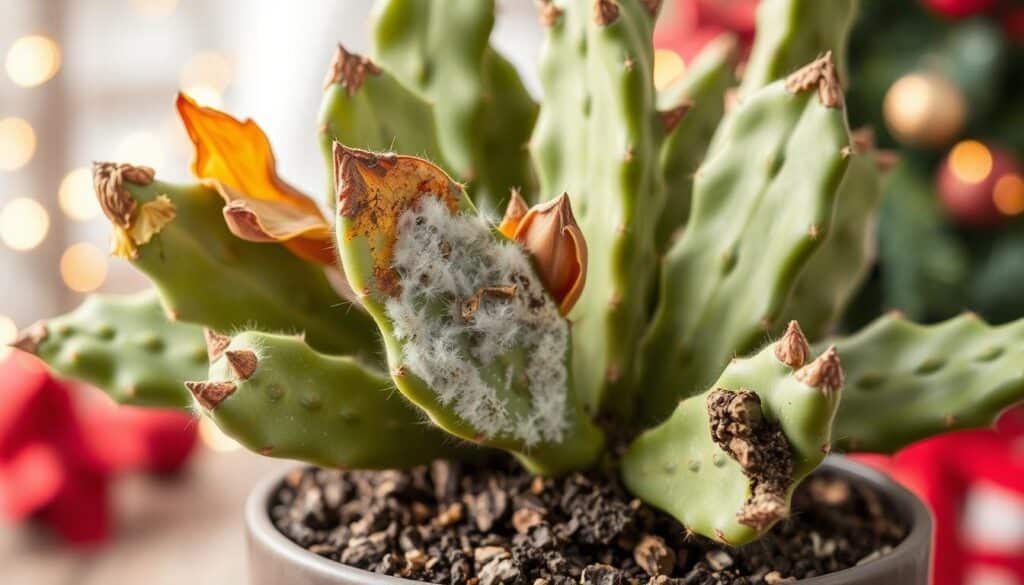
“Maintaining proper cultural care and providing adequate ventilation can help prevent disease in Christmas cacti.”
Bacterial Diseases in Christmas Cactus
Keeping your Christmas cactus healthy means knowing about bacterial diseases. Bacterial soft rot is a big problem. It can cause serious damage if not treated.
Bacterial Soft Rot: Symptoms to Watch For
Look out for water-soaked spots on stems or leaves. These areas might turn brown or black. They can also smell bad as they get soft and mushy. If it gets worse, the whole plant could fall apart.
Preventive Measures for Bacterial Issues
- Don’t overwater your Christmas cactus. Too much water helps bacteria grow.
- Make sure your plant has good air flow. This stops humid, stagnant air that bacteria like.
- Use clean tools when you prune or handle your cactus. This stops bacteria from spreading.
If your cactus gets bacterial soft rot, act fast. Cut off any bad parts and treat the rest with a copper-based solution. Being careful and taking action early can help keep your schlumbergera plants healthy.
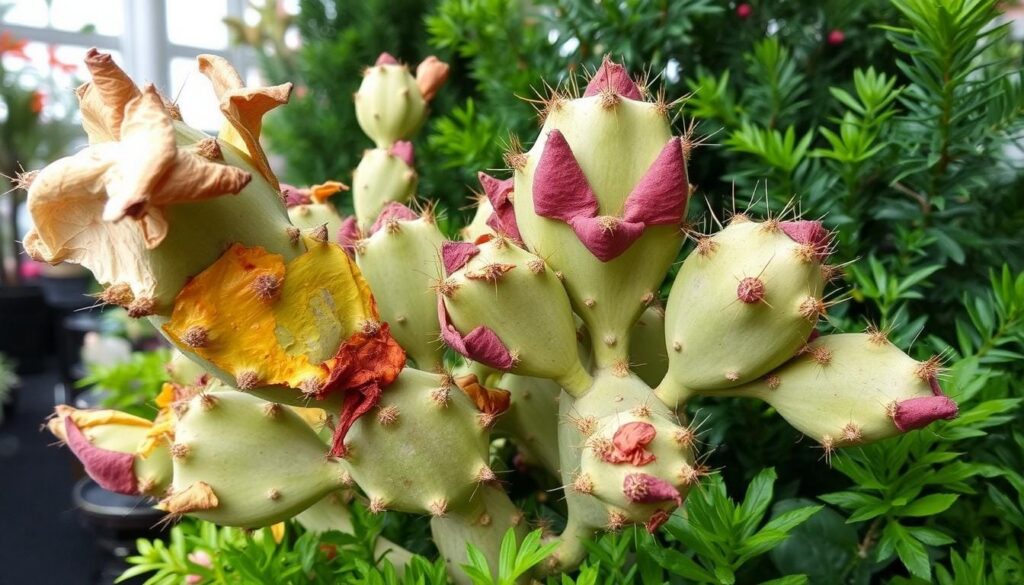
Pest-Related Problems
Christmas cacti can get pests like aphids, mealybugs, spider mites, and fungus gnats. These pests harm their health and look. They can make leaves change color, grow slowly, and spread diseases like necrotic spot virus.
Common Pests: Aphids and Mealybugs
Aphids are small, soft, and can be green, brown, or black. They suck plant sap, leaving sticky stuff that attracts mold. Mealybugs are white, fluffy, and grow fast if not stopped.
How to Identify Pest Infestations
- Look for small insects, webbing, or sticky residue on your Christmas cactus.
- Check the undersides of leaves and where leaves meet stems, as pests hide there.
- Unusual growth or color changes might mean pests are present.
Effective Pest Control Methods
To fight pests on your Christmas cactus, try these:
- Use insecticidal soaps or neem oil on affected areas, following the instructions.
- Bring in beneficial bugs like ladybugs or lacewings to control pests.
- Keep your plant clean by checking it often and isolating new plants before adding them.
By watching closely and acting early, you can keep your Christmas cactus healthy. This way, it will stay pest-free and bring joy to your home for many years.
Environmental Factors Influencing Cactus Health
Keeping our Christmas cactus plants healthy is a delicate task. It involves balancing several environmental factors. These include lighting, temperature, and humidity, all of which are crucial for our plants’ growth and health.
Importance of Proper Lighting
Christmas cacti need the right amount of light to thrive. They do best in bright, indirect light for at least six hours a day. Direct sunlight can harm them, causing leaf discoloration and even burning. So, it’s important to place them where they get the right amount of light.
Effects of Temperature Fluctuations
The perfect temperature for Christmas cacti is between 60-70°F (15-21°C). This range helps them grow and bloom well. But, sudden or extreme temperature changes can harm them. Keeping the temperature steady is key to their health.
The Role of Humidity in Plant Health
Humidity also affects our Christmas cactus. They prefer a moderate humidity level, around 50-70%. If it’s too low, they might drop their buds. Too high, and they could get fungal diseases. So, it’s important to keep the humidity right.
| Environmental Factor | Ideal Range | Impact on Plant Health |
|---|---|---|
| Lighting | Bright, indirect light for 6+ hours daily | Insufficient light can prevent blooming; direct sunlight can cause leaf damage |
| Temperature | 60-70°F (15-21°C) | Temperature fluctuations can lead to flower drop and stunted growth |
| Humidity | 50-70% | Low humidity causes bud drop; high humidity promotes fungal diseases |
By monitoring and maintaining the right environment for our christmas cactus diseases, holiday cactus problems, schlumbergera diseases, we can keep them healthy and blooming beautifully.

Preventative Care for Christmas Cactus
To keep your Christmas cactus healthy, you need to take care of it before problems start. Follow best practices for watering, soil, and fertilizing. This will help your cactus stay away from cactus plant diseases, holiday cactus problems, and christmas cactus diseases.
Best Practices for Watering
Water your Christmas cactus when the top inch of soil feels dry. Don’t overwater, as it can cause root rot and fungal infections. These plants prefer moderate, consistent moisture and don’t like wet soil.
Choosing the Right Soil
Choose a well-draining cactus or succulent soil mix for your Christmas cactus. They do well in slightly acidic, nutrient-rich soil that drains excess moisture. Don’t use regular potting soil, as it can hold too much water and cause root problems.
Fertilization Guidelines
Feed your Christmas cactus a balanced, water-soluble fertilizer monthly from spring to fall. Use a fertilizer made for cacti and succulents. Follow the instructions carefully to avoid over-fertilizing, which can harm the plant.
Keeping humidity levels right, cleaning regularly, and pruning dead parts can also prevent diseases. With a bit of proactive care, your Christmas cactus will stay healthy and beautiful for many years.
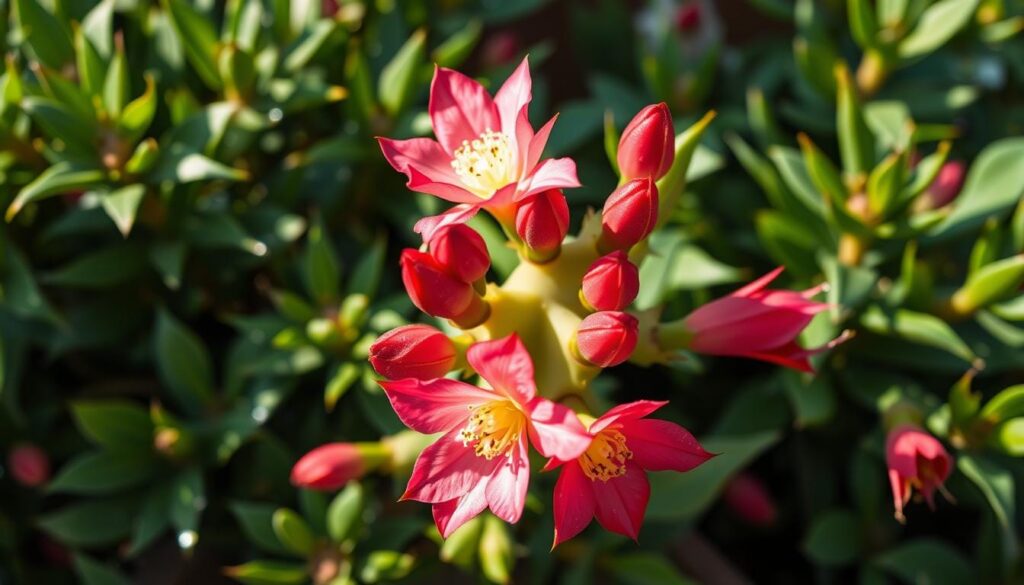
Seasonal Challenges for Christmas Cactus
As holiday cacti like the Christmas cactus go through the seasons, they face special challenges. Knowing these challenges helps keep your schlumbergera plants healthy and blooming.
Winter Care Tips for Your Cactus
In winter, holiday cacti need less water and cooler temperatures for their beautiful flowers. Keep your cactus away from cold drafts and heating vents. This helps it stay in its natural sleep and grow buds.
Also, water it just enough to keep it moist but not too wet. This prevents it from drying out or getting root rot.
Summer Stressors: What to Look For
In warmer weather, christmas cactus plants can get sunburned and dehydrated. Watch for signs of stress like leaf drop or color change. Adjust the light and water to meet its needs.
Give it bright, indirect light and enough water to prevent schlumbergera diseases.
By knowing the challenges holiday cacti face all year and adjusting care, your plants will thrive. They will give you lots of colorful blooms every season.
Post-Disease Recovery for Christmas Cactus
After treating a diseased Christmas cactus, it’s key to watch it closely. We’ll look at signs to check for and when to repot. This helps the plant get back to its vibrant state.
Signs of Recovery to Watch For
As the Christmas cactus, known as Schlumbergera, starts to get better, we’ll see good signs. Look for new growth, better color, and more energy. These signs mean the treatment worked, and the cactus is getting better.
Don’t fertilize the plant right after treatment. This can stress it more. Let it get stronger first before starting regular care again.
When to Repot After Infection
If the Christmas cactus had severe root rot or infections, it might need new soil. But wait until it clearly shows it’s getting better. Repotting too early can harm its recovery.
When the cactus starts growing new, looks better, and seems more alive, it’s time to repot. This gives it a fresh, nutrient-rich soil to heal and grow. Use a mix made for cacti to avoid problems later.
By watching the Christmas cactus closely and following the right steps, we can help it get healthy again. With patience and care, it will keep thriving and bring beauty for years.
“The Christmas cactus can live for up to 100 years, showcasing its longevity and durability as a houseplant.”
Conclusion: Maintaining a Healthy Christmas Cactus
Keeping a Christmas cactus healthy needs our ongoing care and watchfulness. We should check for early signs of diseases like christmas cactus diseases and holiday cactus problems. Also, we must water them right and give them the best environment.
Knowing about the diseases and how to treat them helps us act fast when problems show up. This way, we can keep our Christmas cacti happy and blooming for many holidays.
Christmas cacti are very popular during the holidays, next to poinsettias. They can live a long time, making them great for passing down through generations. By taking good care of them, we can keep them looking great for years.
Being careful and knowing what our Christmas cacti need is the secret to their health. By watching out for problems and fixing them quickly, we can enjoy their beauty all holiday season and beyond.
